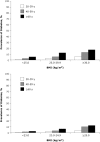Prevalence of diabetes and impaired fasting glucose in Chinese adults, China National Nutrition and Health Survey, 2002
- PMID: 21159225
- PMCID: PMC3044024
Prevalence of diabetes and impaired fasting glucose in Chinese adults, China National Nutrition and Health Survey, 2002
Abstract
Introduction: As a result of rapid economic development in China, the lifestyles and dietary habits of its people have been changing, and the rates of obesity, diabetes, and other chronic conditions have increased substantially. We report the prevalence of type 2 diabetes and impaired fasting glucose (IFG) and the association between diabetes and overweight and obesity in Chinese adults. We also compare the results with those from the US National Health and Nutrition Examination Survey, 1999-2002.
Methods: Data were from adults aged 20 years or older who participated in the China National Nutrition and Health Survey, 2002 (n = 47,729). Diabetes and IFG were defined by the American Diabetes Association 2009 criteria. We assessed the prevalence of diabetes, IFG, and overweight and obesity by sex, age, region of residence, and ethnicity.
Results: The prevalence of diabetes and IFG in Chinese adults was 2.7% and 4.9%, respectively. The prevalence of diabetes increased with age and body mass index. Men and women had a similar prevalence of diabetes, but men had a significantly higher prevalence of IFG. The prevalence of diabetes among Chinese who lived in urban areas was 2 to 3 times higher than the prevalence among those who lived in rural areas (3.9% for urban areas and 6.1% for large cities vs 1.9% for rural areas), and the prevalence of IFG was 1.5 to 2 times higher (6.1% and 8.1% vs 4.2%, respectively). The prevalence of diabetes among Chinese women and young (20-39 y) and middle-aged (40-59 y) adults who lived in large cities was similar to the prevalence of diabetes in the US population.
Conclusion: The prevalence of diabetes and IFG was much higher in urban than rural areas, particularly in the large cities of China. Prevention must be emphasized among adults to reduce the future social and economic burden of diabetes in China.
Figures


References
-
- Wang Y, Mi J, Shan XY, Wang QJ, Ge KY, Wang Y, et al. Is China facing an obesity epidemic and the consequences? The trends in obesity and chronic disease in China. Int J Obes (London) 2007;31(1):177–188. - PubMed
-
- Pan XR, Yang WY, Li GW, Liu J. Prevalence of diabetes and its risk factors in China, 1994. National Diabetes Prevention and Control Cooperative Group. Diabetes Care. 1997;20(11):1664–1669. - PubMed
-
- Gu D, Reynolds K, Duan X, Xin X, Chen J, Wu X, et al. Prevalence of diabetes and impaired fasting glucose in the Chinese adult population: International Collaborative Study of Cardiovascular Disease in Asia (InterASIA) Diabetologia. 2003;46(9):1190–1198. - PubMed
-
- Wang K, Li T, Xiang H. Study on the epidemiological characteristics of diabetes mellitus and IGT in China [in Chinese] Zhonghua Liu Xing Bing Xue Za Zhi. 1998;19(5):282–285. - PubMed
-
- He J, Neal B, Gu D, Suriyawongpaisal P, Xin X, Reynolds R, et al. International Collaborative Study of Cardiovascular Disease in Asia: design, rationale, and preliminary results. Ethn Dis. 2004;14(2):260–268. - PubMed
Publication types
MeSH terms
Substances
Grants and funding
LinkOut - more resources
Full Text Sources
Medical
Research Materials

